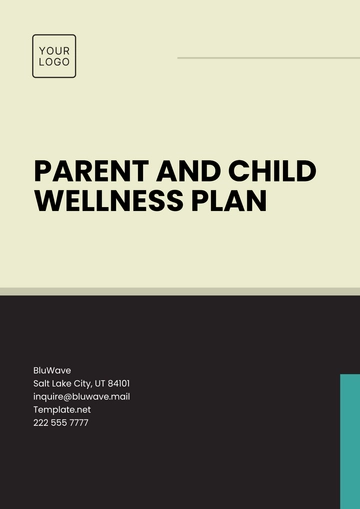Free Men???s Health Wellness Plan

Prepared by: [Your Name]
Company: [Your Company Name]
Date: [Insert Date]
I. Introduction
Men’s health is a critical component of overall well-being, yet many men face unique challenges that can impact their physical, mental, and emotional health. This Men’s Health Wellness Plan is designed to address these challenges by providing a framework for preventive care, education, and access to resources that promote a healthier lifestyle. The plan aims to encourage men to take charge of their health through informed decisions and consistent action, fostering long-term wellness.
II. Vision and Goals
A. Vision
To create a supportive environment where men prioritize their health and are equipped with the tools, knowledge, and resources to live healthier, more fulfilling lives.
B. Goals
Encourage Preventive Care
Promote regular health checkups and screenings to detect potential health issues early.Enhance Physical Wellness
Support men in achieving fitness, maintaining a healthy weight, and adopting nutritious diets.Address Mental Health
Break the stigma surrounding mental health by offering resources for stress management, counseling, and emotional resilience.Promote Healthy Lifestyle Choices
Raise awareness about the impact of smoking, alcohol, poor diet, and lack of exercise on long-term health.Raise Awareness of Male-Specific Conditions
Educate men about prostate health, testicular cancer, cardiovascular risks, and other gender-specific health concerns.Build Community and Support Networks
Foster connections through peer groups, mentorship opportunities, and community events to enhance social well-being.
III. Key Areas of Focus and Strategies
A. Physical Health and Nutrition
Strategies:
Fitness Programs: Provide access to gyms, personal trainers, or group exercise classes tailored to men’s fitness needs.
Healthy Eating Initiatives: Offer meal-prep workshops, nutrition counseling, and resources to promote balanced diets.
Weight Management: Develop programs to help men maintain healthy body weight through structured coaching.
Chronic Disease Prevention: Target conditions like heart disease, diabetes, and obesity through lifestyle interventions.
B. Mental Health and Emotional Resilience
Strategies:
Counseling Services: Provide access to therapists and counselors for stress, anxiety, depression, or other mental health challenges.
Workshops on Emotional Intelligence: Teach men how to manage emotions, improve relationships, and cope with stress.
Peer Support Groups: Create safe spaces for men to share their experiences and receive encouragement.
Stress Management Techniques: Introduce mindfulness, meditation, and relaxation practices to reduce daily stress.
C. Preventive Screenings and Healthcare
Strategies:
Annual Health Checkups: Encourage men to schedule regular visits with primary care physicians.
Screenings for Chronic Conditions: Focus on early detection of high blood pressure, high cholesterol, and diabetes.
Cancer Screenings: Educate men on the importance of prostate exams, testicular self-examinations, and colonoscopies.
Vaccination Campaigns: Provide access to recommended vaccines, including flu and shingles vaccines.
D. Lifestyle Changes and Risk Reduction
Strategies:
Smoking Cessation Programs: Offer support groups and nicotine replacement therapies to help men quit smoking.
Alcohol Awareness: Educate on the risks of excessive alcohol consumption and promote moderation.
Work-Life Balance: Provide tools for managing time effectively to reduce stress and enhance productivity.
Sleep Hygiene Education: Offer guidance on improving sleep quality and addressing sleep disorders.
E. Male-Specific Health Concerns
Strategies:
Prostate Health Education: Raise awareness of symptoms and preventive measures for prostate-related conditions.
Testicular Cancer Awareness: Encourage self-examinations and early detection through educational resources.
Cardiovascular Health: Provide tools to monitor heart health, including fitness programs and dietary advice.
Hormonal Health: Address concerns related to testosterone levels, sexual health, and aging.
F. Community Engagement and Social Support
Strategies:
Mentorship Programs: Pair young men with mentors to promote positive development in health and lifestyle choices.
Community Events: Host health fairs, sports tournaments, and wellness workshops to engage men actively.
Accessible Resources: Partner with local organizations to ensure men in underserved communities have access to wellness resources.
Family and Relationship Support: Offer resources to strengthen family bonds and relationships, recognizing their impact on overall health.
IV. Implementation Plan
A. Roles and Responsibilities
Healthcare Providers: Offer screenings, medical care, and advice tailored to men’s health needs.
Fitness Experts: Lead exercise programs and provide guidance on achieving fitness goals.
Mental Health Professionals: Deliver counseling services and lead workshops on emotional well-being.
Community Leaders: Advocate for men’s health initiatives and organize local events.
B. Timeline
Phase 1 (Months 1-3): Launch awareness campaigns and establish partnerships with healthcare providers.
Phase 2 (Months 4-6): Begin offering fitness programs, mental health workshops, and nutrition counseling.
Phase 3 (Months 7-12): Expand cancer screenings, chronic disease prevention programs, and community events.
Ongoing: Maintain regular checkups, educational resources, and wellness initiatives.
V. Evaluation and Assessment
A. Key Performance Indicators (KPIs)
Increased participation in preventive screenings and fitness programs.
Higher awareness of male-specific health issues such as prostate and testicular cancer.
Improved mental health outcomes through counseling and support groups.
Adoption of healthier lifestyle habits, including smoking cessation and better nutrition.
Enhanced community involvement through workshops and events.
B. Methods of Evaluation
Collect feedback through surveys and focus groups.
Track participation in health programs and events.
Monitor improvements in health metrics such as BMI, blood pressure, and cholesterol levels.
Analyze outreach effectiveness in underserved communities.
VI. Sustainability Plan
Strategies:
Partnerships: Work with healthcare providers, fitness centers, and nonprofit organizations to sustain initiatives.
Funding Opportunities: Apply for grants and sponsorships to support long-term wellness programs.
Volunteer Engagement: Build a network of volunteers to help implement and maintain wellness activities.
Ongoing Education: Use digital platforms and newsletters to continue sharing health tips and updates.
VII. Conclusion
The Men’s Health Wellness Plan is a comprehensive approach to addressing the unique health needs of men. By focusing on preventive care, lifestyle changes, mental health, and community support, this plan empowers men to take proactive steps toward healthier lives. Through collaboration and sustained efforts, we can create a culture where men prioritize their well-being and thrive physically, mentally, and emotionally.
- 100% Customizable, free editor
- Access 1 Million+ Templates, photo’s & graphics
- Download or share as a template
- Click and replace photos, graphics, text, backgrounds
- Resize, crop, AI write & more
- Access advanced editor
You may also like
- Finance Plan
- Construction Plan
- Sales Plan
- Development Plan
- Career Plan
- Budget Plan
- HR Plan
- Education Plan
- Transition Plan
- Work Plan
- Training Plan
- Communication Plan
- Operation Plan
- Health And Safety Plan
- Strategy Plan
- Professional Development Plan
- Advertising Plan
- Risk Management Plan
- Restaurant Plan
- School Plan
- Nursing Home Patient Care Plan
- Nursing Care Plan
- Plan Event
- Startup Plan
- Social Media Plan
- Staffing Plan
- Annual Plan
- Content Plan
- Payment Plan
- Implementation Plan
- Hotel Plan
- Workout Plan
- Accounting Plan
- Campaign Plan
- Essay Plan
- 30 60 90 Day Plan
- Research Plan
- Recruitment Plan
- 90 Day Plan
- Quarterly Plan
- Emergency Plan
- 5 Year Plan
- Gym Plan
- Personal Plan
- IT and Software Plan
- Treatment Plan
- Real Estate Plan
- Law Firm Plan
- Healthcare Plan
- Improvement Plan
- Media Plan
- 5 Year Business Plan
- Learning Plan
- Marketing Campaign Plan
- Travel Agency Plan
- Cleaning Services Plan
- Interior Design Plan
- Performance Plan
- PR Plan
- Birth Plan
- Life Plan
- SEO Plan
- Disaster Recovery Plan
- Continuity Plan
- Launch Plan
- Legal Plan
- Behavior Plan
- Performance Improvement Plan
- Salon Plan
- Security Plan
- Security Management Plan
- Employee Development Plan
- Quality Plan
- Service Improvement Plan
- Growth Plan
- Incident Response Plan
- Basketball Plan
- Emergency Action Plan
- Product Launch Plan
- Spa Plan
- Employee Training Plan
- Data Analysis Plan
- Employee Action Plan
- Territory Plan
- Audit Plan
- Classroom Plan
- Activity Plan
- Parenting Plan
- Care Plan
- Project Execution Plan
- Exercise Plan
- Internship Plan
- Software Development Plan
- Continuous Improvement Plan
- Leave Plan
- 90 Day Sales Plan
- Advertising Agency Plan
- Employee Transition Plan
- Smart Action Plan
- Workplace Safety Plan
- Behavior Change Plan
- Contingency Plan
- Continuity of Operations Plan
- Health Plan
- Quality Control Plan
- Self Plan
- Sports Development Plan
- Change Management Plan
- Ecommerce Plan
- Personal Financial Plan
- Process Improvement Plan
- 30-60-90 Day Sales Plan
- Crisis Management Plan
- Engagement Plan
- Execution Plan
- Pandemic Plan
- Quality Assurance Plan
- Service Continuity Plan
- Agile Project Plan
- Fundraising Plan
- Job Transition Plan
- Asset Maintenance Plan
- Maintenance Plan
- Software Test Plan
- Staff Training and Development Plan
- 3 Year Plan
- Brand Activation Plan
- Release Plan
- Resource Plan
- Risk Mitigation Plan
- Teacher Plan
- 30 60 90 Day Plan for New Manager
- Food Safety Plan
- Food Truck Plan
- Hiring Plan
- Quality Management Plan
- Wellness Plan
- Behavior Intervention Plan
- Bonus Plan
- Investment Plan
- Maternity Leave Plan
- Pandemic Response Plan
- Succession Planning
- Coaching Plan
- Configuration Management Plan
- Remote Work Plan
- Self Care Plan
- Teaching Plan
- 100-Day Plan
- HACCP Plan
- Student Plan
- Sustainability Plan
- 30 60 90 Day Plan for Interview
- Access Plan
- Site Specific Safety Plan





























